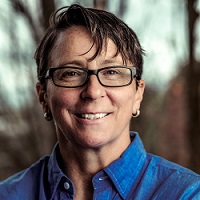Kris Hermanns, Pride Foundation
 On the job since: January 2012
On the job since: January 2012
Foundation founded in: 1985
Geographic scope: Alaska, Idaho, Montana, Oregon & Washington
Grants made in 2015: $6.9M
Staff: 15 FTE
Percentage of staff representing communities of color: 31%
How did you come to the decision to host a Momentum Fellow?
Ever since the idea surfaced within conversations among Philanthropy Northwest's CEO cohort on diversity, equity and inclusion, I was interested in hosting a fellow at Pride Foundation. Most important, the Momentum Fellowship was a tangible way to match our commitment to racial equity with real actions and change. In addition, as a regional community foundation focused on equity in support of a specific population and across a range of issues, I thought we could offer a unique experience for someone. The vibrant and growing community of LGBTQ organizations in Oregon, as well as the robust philanthropic sector, also created opportunities that we thought would be beneficial for a fellow to engage in and learn from.
What has been a challenge for you and your foundation, related to diversity, equity and inclusion in philanthropy, and how are you working on it?
We want to do more, more quickly, and more effectively. In this cultural moment when divisions and disparities are growing within our country, we feel a sense of urgency to ensure that our diversity, equity, and inclusion focus is fully integrated into all levels of our organizational practices. It can often feel like we aren’t doing enough or that we have so much more to do. I have to follow my own in advice in this arena (see below) and remember that this is a life-long process — and one that should be engaged with thoughtfully and intentionally, with unwavering commitment.
What have you and your foundation learned from hosting a Momentum Fellow?
I think we all intuitively know and believe that creating intentional learning opportunities can have enormous impacts — for everyone, individually and organizationally. Hosting a Momentum Fellow proved just how tangibly accurate this intuition is. In nine short months, we have seen our Kim Sogge dive fully into her fellowship experience, solidify and make significant progress toward her learning objectives, and grow her leadership both within Pride Foundation and within the broader community. Kim brings her experiences and learning from the Momentum Fellowship cohort back to Pride Foundation, increasing our awareness of what we don’t know and offering ideas for what we could be doing better.
What would success look like for philanthropy and diversity, equity and inclusion?
Ultimately, diversity, equity and inclusion aren’t ends in themselves — they are tools to get at the root causes of injustices so that we can more effectively make real and significant changes to the systems that perpetuate them. Some examples, though, of what success for philanthropy around diversity, equity and inclusion would look like include:
- An increase in grant dollars invested in addressing inequities in partnership with organizations that are led by people facing the greatest disparities — people of color, immigrants, indigenous people, LGBTQ people, people living in rural communities, etc.
- Representation of the people and communities who are served by philanthropy across and in the highest levels of leadership within philanthropy.
- Genuine engagement by philanthropy with the people and communities most impacted by injustices in decision making about the solutions to issues that are affecting them.
What advice would you give to other foundations interested in hosting a Momentum Fellow and/or integrating diversity, equity and inclusion into their work?
For both hosting a fellow and integrating diversity, equity, and inclusion into their work, I would recommend always remembering that it is a life-long process. This means that you have to be continually attentive to it, finding ways to engage further and in more complex and sometimes uncomfortable ways. This has to remain at the forefront of your thinking and your approach. Thinking of both as a process also means creating space to be adaptive and flexible as your learning deepens — because the very nature of learning means that you are going to experience dissonance and it’s going to change things, and you have to be willing to accommodate for that if it’s going to be impactful.
What’s a resource you would recommend to funders interested in learning more about this work?
The candid, often funny and incredibly insightful Nonprofit With Balls blog by Vu Le is a great resource to think more about issues related to diversity, equity and inclusion in philanthropy and within the nonprofit world. He also often gives pointed and directive feedback to the funding community in particular around these issues. While there are a number of other resources out there you could access (and I’d recommend you doing that research), if you’re going to add one thing to your weekly rotation of articles, Vu’s weekly posts are always thought-provoking.
What’s one more question we should ask you, and how would you answer it?
Q. Regardless of where your foundation is at with respect to diversity, equity, and inclusion, or what your role is there, what is something tangible that you can do to impact change?
A. Ask questions and listen closely. Keep these principles at the forefront of your mind and, in everything you do, wonder how practices that focus on diversity, equity, and inclusion can be explicitly integrated in everything you do to impact the way you are thinking, acting, and working — and then figure out what you need to change.
Kris Hermanns is president and CEO of Pride Foundation, working with Momentum Fellow Kim Sogge.
Learn more about our nine Momentum Fellows and five foundations supporting this fellowship in our July 2016 Virtual Roundtable.